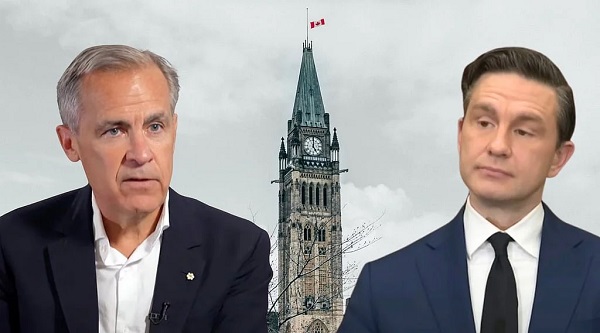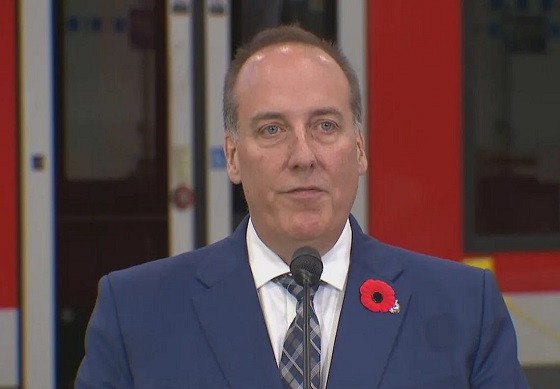Alberta
Rocky View County murder. RCMP charge one with first degree murder; searching for second suspect

News release from Strathmore RCMP
The Alberta RCMP have now laid charges in connection with the tragic shooting which occurred in Rocky View County on Aug. 6, 2024. RCMP have charged Edmonton resident 35-year-old Arthur Wayne Penner with the first-degree-murder of Airdrie resident Colin John Hough as well as attempted murder of another individual. Penner has been arrested and taken before a justice of the peace. He has been remanded into custody with his next court date set for Aug. 15, 2024, at the Alberta Court of Justice in Airdrie.
Additionally, RCMP continue to search for the second suspect in the shooting. Elijah Blake Strawberry, 28-years-old, now has a warrant for his arrest for the second-degree-murder of Colin Hough. RCMP are asking for the public’s assistance in locating Strawberry.
Elijah Strawberry is described as:
- Light complexion
- 6 feet 1 inch tall
- 169 pounds
- Several arm and face tattoos.
- Brown Hair
Elijah Strawberry is considered armed and dangerous. If seen do not approach dial 911 immediately.
The Alberta RCMP wish to offer a timeline into the investigation that led to both an arrest and a warrant for arrest.
On Aug. 6, 2024, around noon hour, officers from the Strathmore RCMP received a report of two men who had been shot while doing work along a roadway on Township Road 250 and Range Road 281 in Rocky View County. Upon arriving on scene, emergency crews discovered that Colin Hough and a 39-year-old victim had both been shot during an attempted robbery by two, then unknown, individuals. The suspects burnt the stolen vehicle they arrived to the scene in, and stole one of the victim’s Rocky View County pick-up trucks.
Responding officers were able locate the suspects in the Rocky View County pick up truck and engaged in a pursuit, however the suspects were successful in evading police.
Soon after, using the Rocky View County pick-up truck on-board GPS, police were able to locate the truck abandoned in a field in the area of Range Road 252 and Township Road 260. Faced with the potential of armed suspects in area, RCMP issued a Police-Initiated Public Alert advising residents in the area to shelter in place. Strathmore RCMP, with assistance of our Emergency Response Team, Calgary Police TAC, Calgary Police Dog Service, the Alberta RCMP helicopter, Calgary HAWCS, drones, and neighbouring detachments, conducted a thorough search of the area. At this point in time police had limited and vague descriptions of the suspects involved in the incident. Providing vague or potentially inaccurate information to the public about the suspects at this crucial time could have been misleading and potentially dangerous.
After conducting a thorough search, RCMP were satisfied that the suspects could no longer be in the area and the immediate risk to residents had subsided. Police at this time lifted the shelter in place and continued to investigate.
After continued investigation, police learned that the suspects, during an unrelated incident, were involved in a minor collision in Calgary in which the stolen vehicle they were driving was partially disabled. They then drove to where the shooting victims were working and attempted to steal a new vehicle. It was at this time both victims were shot.
On Aug. 8, 2024, RCMP determined that Arthur Wayne Penner was one of the suspects. Immediate actions were taken to set up surveillance on Penner and liaise with Alberta Crown Prosecutors to obtained charge approvals. Once the approval was received, RCMP with assistance from Edmonton Police Service, safety arrested Penner in Edmonton.
On Aug. 11, 2024, police identified Elijah Strawberry as the second suspect in this incident. Today, after receiving crown approval, RCMP have obtained a warrant for his arrest. We ask that anyone who sees him or as information about his whereabouts call 911.
“I want to assure everyone that the RCMP has done, and continue to do, everything in our power to swiftly investigate and arrest these dangerous suspects. I give my most heartfelt condolences to the family and friends of Colin Hough who was out working and making a living when these individuals took his life,” says Staff Sergeant Mark Wielgosz, “I also want the other victim in this tragedy to know that our thoughts are with him as well.”
Despite these charges, the RCMP’s investigation continues:
- We continue to work at identifying the occupants of Black Volkswagen Jetta as they may have witnessed this incident. We ask for these individuals to come forward.
- We believe that a quad stolen on Aug. 7, 2024, a 1:34 p.m. in Wheatland County maybe be connected to our investigation. We ask that members of public check their dash cam footage and surveillance cameras if they have seen the quad or its occupants.
Elijah Strawberry is considered armed and dangerous. If seen do no approach – dial 911 immediately. Alberta RCMP are still seeking public’s help with video footage and information surrounding this incident. If you have information about this incident or those responsible, please call the Strathmore RCMP at 403-934-3535. If you want to remain anonymous, you can contact Crime Stoppers by phone at 1-800-222-8477 (TIPS), online at www.P3Tips.com or by using the “P3 Tips” app available through the Apple App or Google Play Store.
Alberta
‘Weird and wonderful’ wells are boosting oil production in Alberta and Saskatchewan

From the Canadian Energy Centre
Multilateral designs lift more energy with a smaller environmental footprint
A “weird and wonderful” drilling innovation in Alberta is helping producers tap more oil and gas at lower cost and with less environmental impact.
With names like fishbone, fan, comb-over and stingray, “multilateral” wells turn a single wellbore from the surface into multiple horizontal legs underground.
“They do look spectacular, and they are making quite a bit of money for small companies, so there’s a lot of interest from investors,” said Calin Dragoie, vice-president of geoscience with Calgary-based Chinook Consulting Services.
Dragoie, who has extensively studied the use of multilateral wells, said the technology takes horizontal drilling — which itself revolutionized oil and gas production — to the next level.
“It’s something that was not invented in Canada, but was perfected here. And it’s something that I think in the next few years will be exported as a technology to other parts of the world,” he said.
Dragoie’s research found that in 2015 less than 10 per cent of metres drilled in Western Canada came from multilateral wells. By last year, that share had climbed to nearly 60 per cent.
Royalty incentives in Alberta have accelerated the trend, and Saskatchewan has introduced similar policy.
Multilaterals first emerged alongside horizontal drilling in the late 1990s and early 2000s, Dragoie said. But today’s multilaterals are longer, more complex and more productive.
The main play is in Alberta’s Marten Hills region, where producers are using multilaterals to produce shallow heavy oil.
Today’s average multilateral has about 7.5 horizontal legs from a single surface location, up from four or six just a few years ago, Dragoie said.
One record-setting well in Alberta drilled by Tamarack Valley Energy in 2023 features 11 legs stretching two miles each, for a total subsurface reach of 33 kilometres — the longest well in Canada.
By accessing large volumes of oil and gas from a single surface pad, multilaterals reduce land impact by a factor of five to ten compared to conventional wells, he said.
The designs save money by skipping casing strings and cement in each leg, and production is amplified as a result of increased reservoir contact.
Here are examples of multilateral well design. Images courtesy Chinook Consulting Services.
Parallel
Fishbone
Fan
Waffle
Stingray
Frankenwells
Alberta
Alberta to protect three pro-family laws by invoking notwithstanding clause

From LifeSiteNews
Premier Danielle Smith said her government will use a constitutional tool to defend a ban on transgender surgery for minors and stopping men from competing in women’s sports.
Alberta Premier Danielle Smith said her government will use a rare constitutional tool, the notwithstanding clause, to ensure three bills passed this year — a ban on transgender surgery for minors, stopping men from competing in women’s sports, and protecting kids from extreme aspects of the LGBT agenda — stand and remain law after legal attacks from extremist activists.
Smith’s United Conservative Party (UCP) government stated that it will utilize a new law, Bill 9, to ensure that laws passed last year remain in effect.
“Children deserve the opportunity to grow into adulthood before making life-altering decisions about their gender and fertility,” Smith said in a press release sent to LifeSiteNews and other media outlets yesterday.
“By invoking the notwithstanding clause, we’re ensuring that laws safeguarding children’s health, education and safety cannot be undone – and that parents are fully involved in the major decisions affecting their children’s lives. That is what Albertans expect, and that is what this government will unapologetically defend.”
Alberta Justice Minister and Attorney General Mickey Amery said that the laws passed last year are what Albertans voted for in the last election.
“These laws reflect an overwhelming majority of Albertans, and it is our responsibility to ensure that they will not be overturned or further delayed by activists in the courts,” he noted.
“The notwithstanding clause reinforces democratic accountability by keeping decisions in the hands of those elected by Albertans. By invoking it, we are providing certainty that these protections will remain in place and that families can move forward with clarity and confidence.”
The Smith government said the notwithstanding clause will apply to the following pieces of legislation:
-
Bill 26, the Health Statutes Amendment Act, 2024, prohibits both gender reassignment surgery for children under 18 and the provision of puberty blockers and hormone treatments for the purpose of gender reassignment to children under 16.
-
Bill 27, the Education Amendment Act, 2024, requires schools to obtain parental consent when a student under 16 years of age wishes to change his or her name or pronouns for reasons related to the student’s gender identity, and requires parental opt-in consent to teaching on gender identity, sexual orientation or human sexuality.
-
Bill 29, the Fairness and Safety in Sport Act, requires the governing bodies of amateur competitive sports in Alberta to implement policies that limit participation in women’s and girls’ sports to those who were born female.”
Bill 26 was passed in December of 2024, and it amends the Health Act to “prohibit regulated health professionals from performing sex reassignment surgeries on minors.”
As reported by LifeSiteNews, pro-LGBT activist groups, with the support of Alberta’s opposition New Democratic Party (NDP), have tried to stop the bill via lawsuits. It prompted the Smith government to appeal a court injunction earlier this year blocking the province’s ban on transgender surgeries and drugs for gender-confused minors.
Last year, Smith’s government also passed Bill 27, a law banning schools from hiding a child’s pronoun changes at school that will help protect kids from the extreme aspects of the LGBT agenda.
Bill 27 will also empower the education minister to, in effect, stop the spread of extreme forms of pro-LGBT ideology or anything else to be allowed to be taught in schools via third parties.
Bill 29, which became law last December, bans gender-confused men from competing in women’s sports, the first legislation of its kind in Canada. The law applies to all school boards, universities, and provincial sports organizations.
Alberta’s notwithstanding clause is like all other provinces’ clauses and was a condition Alberta agreed to before it signed onto the nation’s 1982 constitution.
It is meant as a check to balance power between the court system and the government elected by the people. Once it is used, as passed in the legislature, a court cannot rule that the “legislation which the notwithstanding clause applies to be struck down based on the Charter of Rights and Freedoms, the Alberta Bill of Rights, or the Alberta Human Rights Act,” the Alberta government noted.
While Smith has done well on some points, she has still been relatively soft on social issues of importance to conservatives , such as abortion, and has publicly expressed pro-LGBT views, telling Jordan Peterson earlier this year that conservatives must embrace homosexual “couples” as “nuclear families.”
-

 Crime2 days ago
Crime2 days ago‘Modern-Day Escobar’: U.S. Says Former Canadian Olympian Ran Cocaine Pipeline with Cartel Protection and a Corrupt Toronto Lawyer
-

 National17 hours ago
National17 hours agoPsyop-Style Campaign That Delivered Mark Carney’s Win May Extend Into Floor-Crossing Gambits and Shape China–Canada–US–Mexico Relations
-

 COVID-1913 hours ago
COVID-1913 hours agoCovid Cover-Ups: Excess Deaths, Vaccine Harms, and Coordinated Censorship
-

 Bruce Dowbiggin14 hours ago
Bruce Dowbiggin14 hours agoBurying Poilievre Is Job One In Carney’s Ottawa
-

 Alberta1 day ago
Alberta1 day ago‘Weird and wonderful’ wells are boosting oil production in Alberta and Saskatchewan
-

 Alberta2 days ago
Alberta2 days agoAlberta on right path to better health care
-

 Artificial Intelligence2 days ago
Artificial Intelligence2 days agoLawsuit Claims Google Secretly Used Gemini AI to Scan Private Gmail and Chat Data
-

 Alberta1 day ago
Alberta1 day agoAlberta to protect three pro-family laws by invoking notwithstanding clause










